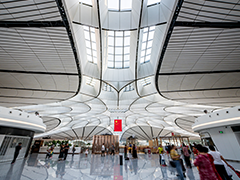Application comparison of video conferencing systems (software and hardware)
- Categories:Industry News
- Time of issue:2021-06-02 15:33
- Views:
(Summary description) it can be seen that large enterprise companies and government departments can select a video conferencing system based on hardware to access a dedicated network in order to pursue a perfect video conferencing effect. The software-implemented video conferencing system also has great advantages.
Application comparison of video conferencing systems (software and hardware)
(Summary description) it can be seen that large enterprise companies and government departments can select a video conferencing system based on hardware to access a dedicated network in order to pursue a perfect video conferencing effect. The software-implemented video conferencing system also has great advantages.
- Categories:Industry News
- Time of issue:2021-06-02 15:33
- Views:

Hardware-based video conferencing products basically follow the basic framework of H.323. The H.323 standard is a standard for packet-switched network-based video multimedia conference communication defined by the ITU organization. Currently, widely used LANs and WANs belong to packet-switched networks. At the same time, the standard also takes into account the characteristics of the traditional PSTN call flow and IP network. H.323 covers a series of standards, such as the packet switched network without packet protection based on packet switching, but can be connected to the H.320 system based on ISDN through the gateway, and connected to the low bit rate H.324 terminal. Wait.
The audio codec standards are G.711, G.723, G.729, etc., the video codec standard is H.261 or H.263, the data transmission standard is T.120, the media stream communication control protocol H.245, call control. Signaling H.225 and so on. The H.323 standard defines several components for real-time media transport: terminals, gateways, gatekeepers, and multipoint control units. Hardware products often combine some or several of several functional modules into one hardware product. For example, the MCU can be a single hardware product, but often the gateway and the gatekeeper make a hardware product according to the user's requirements, and even some user terminals have embedded the MCU part.
Most of the software-only video conferencing system products are developed based on IP networks based on their own architecture. This kind of software system is basically composed of three parts: client side, server side and network transmission in C/S or C/W mode. Some of the software products implement some of its modules in accordance with the H.323 standard, such as gateway, MCU, and Gatekeeper software. In recent years, software-implemented video conferencing systems have appeared on the market more and more. The software video conferencing products on the market include Nanjing Tengshang, Weisuo, Vmeeting system of Dongda Qinhuangdao Software, and Shanda Lianrun video conferencing system. As well as ACMeeting of Longsoft, the following is a comparison of software-based video conferencing systems and hardware-based video conferencing systems.
In terms of audio, audio data is not very bandwidth-intensive. Whether it is hardware implementation or software-implemented video conferencing products, better compression is achieved without distortion.
In terms of video, because the hardware-based video conferencing system, such as the H.320 product itself, is based on a good network of DDN, ISDN, ATM, etc., the network itself provides good audio and video transmission conditions, so the hardware Video conferencing products can provide higher quality video images, such as Polycom's ViewStation512 system, which can achieve 30 frames per second (NTSC) or 25 frames per second (PAL) at 384/512Kbps, with an image resolution of 352×288. The image is jitter free and delayed. Software video conferencing products are mostly built on IP networks, and the effects of hardware products are somewhat different. However, with the improvement of network bandwidth and QoS guarantee, video effects are gradually improving.
In order to realize the video image effect corresponding to its price, the product implemented by the network adaptive hardware often has strict bandwidth requirements. The typical access mode is a dedicated network of ISDN, DDN, and frame relay, which requires high IP network and minimum bandwidth. More than 384kbps, but can not use the existing non-broadband Internet, the operating cost is high; software products can flexibly adjust the bandwidth, use the existing Internet or customer ready-made network, even in the case of ordinary 56KModem dial-up Internet access, can also achieve a single Road remote video 4 frames / sec.
Processing speed The video in the hardware video conference uses the H.26x series and the G.7xx series for audio. It is realized by hardware codec. Due to the large amount of video and audio data, in order to transmit multimedia audio and video data in real time, it needs to be fast. The hardware codec processing speed, these special hardware with a special audio and video codec can well meet this requirement. The software products mainly deal with audio and video data through software, which is completely dependent on the CPU of the host. When the computing power of the host is insufficient, it may cause a certain delay, but now the processor can meet this requirement, and the complete hardware. The gap in product processing speed is getting smaller and smaller.
Transmission delay hardware video conferencing system transmission delay is relatively small, which mainly comes from the unique features of the private network. For example, ATM, Frame Relay, DDN and other networks themselves provide a good guarantee for the transmission delay mechanism; while IP-based video conferencing systems mainly run on the X.25 backbone network, for data processing relative to the above The proposed network has a large delay.
The function provides a hardware-based video conferencing system, generally only supports several simple functions such as electronic whiteboard and split screen display; and the conference system implemented by software can provide more functions according to customers' requirements, for example, can browse any format synchronously. Documents, data sharing, text exchange, meeting voting, convenient conference recording and playback, intelligent meeting reminders, multiple meeting modes, setting someone as a speaker and driving someone out of a meeting room.
The stability-based hardware-based video conferencing system itself is based on the H.323 standard and has strong stability; software-based video conferencing systems may have some stability problems due to the effects of encoding and running platforms and server load, but It can be improved gradually through comprehensive debugging.
The video conferencing system with easy-to-operate hardware has simple functions and easy operation. The software video conferencing system is powerful and has a good user-friendly interface design. Just click the button at the prompt to complete the desired operation.
The software advantages of scalability and self-design are obvious. The self-developed video conferencing system is generally implemented entirely in software, so it can be easily made into components or middleware products for secondary development and porting. For example, if you change the four-channel video into two-way video, you can easily embed the web page into a video phone and online consultation system and other video applications. Once the hardware products are invested, the scope of scalability is much smaller, and there is no advantage in this respect.
The H.323 framework based on security assurance hardware is relatively mature and has a good security mechanism for H.235 protection. Products developed with independent property rights need to be designed by themselves in terms of safety.
The price hardware video conferencing system has to purchase special terminals and MCUs, and also has a special network operating environment, which is expensive. Many SMEs and individuals are discouraged, which is also an important factor in the widespread popularity of video conferencing systems. Video conferencing systems implemented in software only need to use ordinary PCs or mobile PCs to install ordinary audio and video recording devices. It can be exchanged and cheap, suitable for small and medium-sized enterprises and individuals.
From the above analysis, it can be seen that large enterprise companies and government departments can select a video conferencing system based on hardware to access a dedicated network in order to pursue a perfect video conferencing effect. The software-implemented video conferencing system also has great advantages. For small and medium-sized enterprises and individuals, it is possible to focus on the software video conferencing system and the network that they can access to build their own video conferencing system.
Scan the QR code to read on your phone
Related News

OBT WeChat

OBT Mobile Website
Copyright © Shenzhen OBTPA Technology Co.,Ltd. 粤ICP备18028288号





